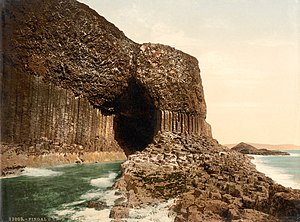Staffa
| Staffa | ||
|---|---|---|
| Fingals cave around 1900 | ||
| Waters | Atlantic Ocean | |
| Archipelago | Inner Hebrides | |
| Geographical location | 56 ° 26 '11 " N , 6 ° 20' 27" W | |
|
|
||
| length | 600 m | |
| width | 200 m | |
| Residents | uninhabited | |
| View from the sea | ||
Staffa (from Old Norwegian , Scottish Gaelic : Stafa , English also Isle of Staffa ) is a rocky island on the west coast of Scotland that belongs to the Inner Hebrides . The Vikings already knew the island. The name Staffa is derived from their word for "island of pillars".
geography
The island is only 200 by 600 meters in size and uninhabited, but is visited daily by excursion boats in summer, as there are several well-known sights.
On Staffa there are polygonal columns made of basalt that formed when lava poured out cooled down ( Staffa Magma Type , SMT). The emergence of large amounts of magma, which occurred around 60 million years ago (Tertiary), is responsible for the formation of such flood basalt ceilings. These basalts occur under the sea to neighboring islands such as Mull ( Mull Plateau Group , MPG) and Skye ( Skye Main Lava Series , SMLS) and extend as far as Northern Ireland to the Giant's Causeway . There is also the famous Fingals Cave on the island , which was formed by the force of the waves and extends into the large basalt columns. It is 80 meters long and 10 meters wide and was named after the Celtic legendary hero Fingal , invented by the writer James Macpherson .
The most important neighboring islands of Staffa include Mull and Iona .
history
The earliest documented human presence on the island dates back to around 1800 BC. BC, although it is still unclear whether these were sporadic visits from the mainland or a permanent settlement.
In the 19th century, numerous well-known personalities traveled to Staffa. Among them were Queen Victoria and her husband Prince Albert . William Turner came to Staffa to paint there. William Wordsworth explored the island and Carl Gustav Carus created several paintings there as well. The Fingals Cave inspired the composer Felix Mendelssohn Bartholdy to write his Hebrides Overture after his visit in 1829 . Even Theodor Fontane visited the island on his trip to Scotland in the summer. 1858 He described his impressions in the book Beyond the Tweed .
The stamp dealer Clive Feigenbaum had stamps printed for Staffa whose postal use is questioned, but they were officially approved. Later editions could also be sent via a mailbox.
Since 1986 the island has been administered by the National Trust for Scotland .
fauna

There is a seabird colony on Staffa that includes several hundred puffins .
Web links
Individual evidence
- ^ A b c Gordon Y. Craig (ed.): Geology of Scotland . The Geological Society , London 1991 pp. 487, 490
- ^ Charles Henry Emeleus et al .: Mull Lava Group, Palaeogene volcanic districts of Scotland . on www.earthwise.bgs.ac.uk (English) (Copac: bibliographic evidence )
- ↑ Alison Campsie: Staffa 'home to humans' 3,800 years ago. In: The Scotsman . August 9, 2018, accessed September 18, 2018 .


